Flaky Buttermilk Biscuits
This post may contain affiliate links. Please read my disclosure policy.
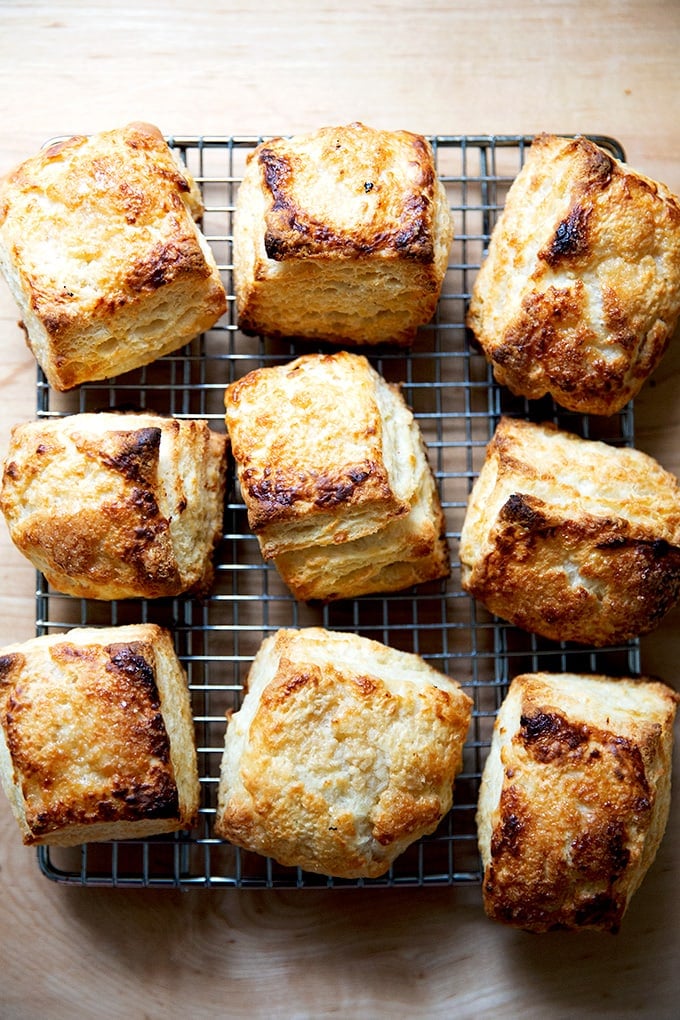
A few weeks ago, I made a batch of buttermilk biscuits to serve with dinner. The biscuits emerged as they always do, sugar-crusted with a light, tender interior. Everyone gobbled them up, and while historically this has been a biscuit I love, this recent batch left me wanting: more butter, more flakiness, more salt.
In need of guidance, I turned to my baking cookbooks, and in Melissa Weller’s A Good Bake, I came across a recipe for flaky buttermilk biscuits. Her recipe called for a higher proportion of butter, less sugar, and more salt. She described the biscuits as “soft and flaky, rich with butter, and with a lot of layers you can see from the sides.”
It sounded promising. I made them, and much to my delight, the family — and I — gobbled them up. These, to me, are perfection. When broken apart from end to end, the biscuits open accordion-style, each pleat flaking into the next. The exterior is crisp and burnished and a little bit sweet thanks to a sprinkling of turbinado sugar. Heavenly on their own, these biscuits are even better with a slick more of salted butter. What isn’t?
I have made a few small changes to the recipe — I’ve added a teensy bit more salt (just a gram!), more baking powder (to encourage a little more lift), and more buttermilk, which I found essential to get the dough into a cohesive ball without overworking it. I also employ a few other tricks I’ve adopted since learning this previously favored buttermilk biscuit recipe, which, I must note, still produces an excellent biscuit, also flaky in texture, but softer and lighter, which some people might find preferable. (Though they do need more salt … I’ve updated the recipe.)
I’ve summed up all of my biscuit making knowledge here:
8 Tips for Excellent Buttermilk Biscuits
- As always: use a scale for best results. The difference between 9 and 10 grams of salt may seem negligible, but it makes a difference (i.e. 10 grams is better.) Moreover, if you use cups to measure the flour you’ll end up using more or less than what is called for, which will require using more or less buttermilk.
- To create those visible flaky layers, it’s all about the rolling and folding. In this recipe, you’ll roll the dough into a 14-inch rectangle, fold it envelope style, turn the dough 90 degrees; then repeat twice more.
- Cold butter, cold buttermilk. This is not unlike the process for making pie dough. Using cold ingredients, working quickly, and not overworking the dough is important. Here, I use a pastry cutter to cut the butter into the dry ingredients, but you absolutely could use a food processor: ten 1-second pulses should do it.
- For a no-fuss process, cut the biscuits into squares (as opposed to rounds, which require re-rolling the scraps).
- Chill the cut biscuits in the fridge for 30 minutes before baking.
- Brushing the biscuits with cream, buttermilk or an egg wash encourages browning. A sprinkling of turninado (or other) sugar creates that irresistible salty-sweet dynamic.
- For me: baking in the upper third of the oven encourages the best browning. (Every oven is different, however, so watch closely and adjust accordingly.)
- If you find the bottoms of your biscuits get brown too quickly, double up on the sheetpans for baking — I do this with my challah recipe, and it works beautifully to prevent overbrowning on the bottom.
How to Make These Biscuits Ahead Of Time (Fridge/Freezer)
There are three ways you can make these biscuits ahead of time:
- You can freeze the baked and completely cooled biscuits in an airtight container for up to 3 months. Thaw them overnight at room temperature. Reheat them at 350ºF for 15 minutes before serving.
- You can transfer the unbaked portioned biscuits (or the square of biscuit dough) to the fridge for as long as 2 days.
- You can freeze the unbaked portioned biscuits. Freeze the cut biscuits (without the buttermilk wash or sugar topping) on a sheet pan. Once frozen, transfer to an airtight bag or vessel and freeze for up to 3 months. Bake them directly from the freezer — apply the buttermilk wash and sugar to the frozen biscuits — then transfer to the oven. The biscuits will need a few more minutes so rely on visual cues: golden tops and bottoms.
How to Make Buttermilk Biscuits, Step by Step
Gather your ingredients: only six! Flour, butter, buttermilk, salt, sugar, baking powder.
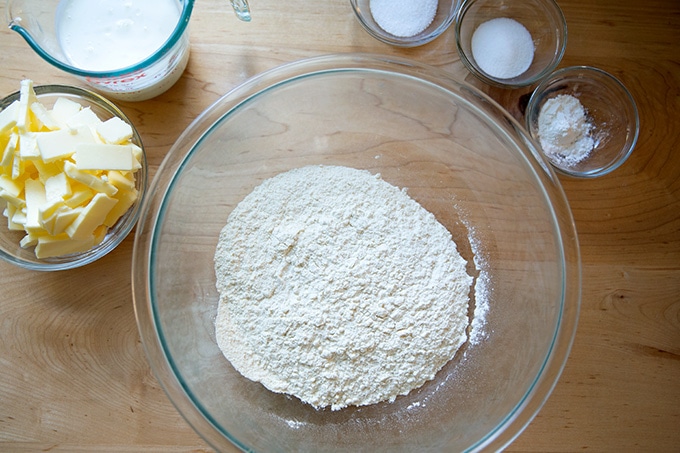
Whisk together the dry ingredients.

Add the cold, cubed butter.
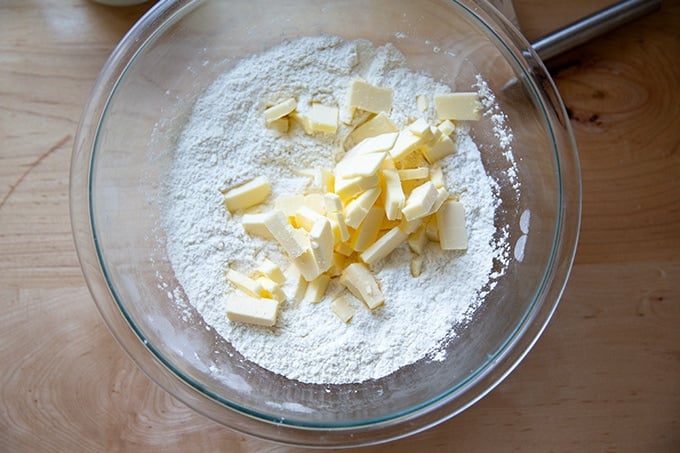
Cut the butter in using a pastry cutter or the back of a fork. You also could do this in the food processor.

Add the buttermilk …

… and stir to combine.
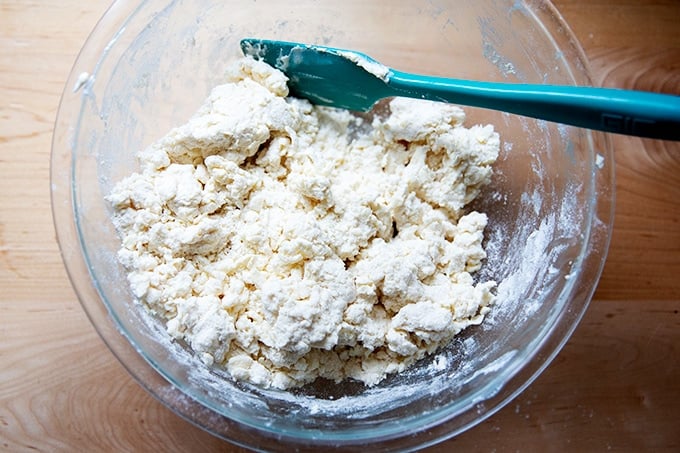
You may need to knead the dough briefly with your hands to get it into a cohesive ball.

Turn the dough out onto a work surface and pat into a square.

Roll out into a 14-inch long rectangle.
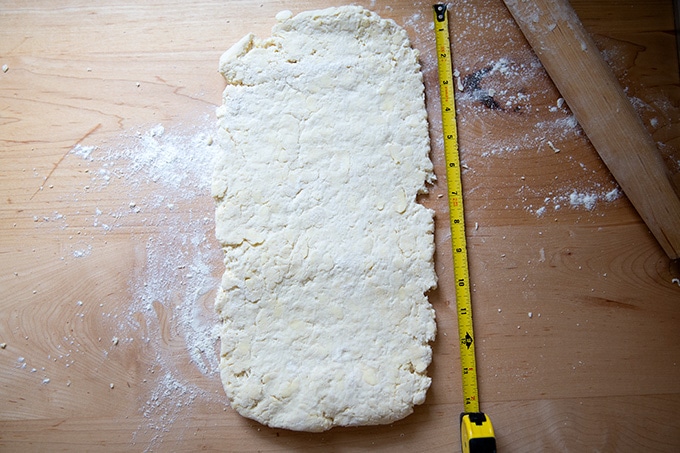
Fold the top third down.

Fold the bottom third up.
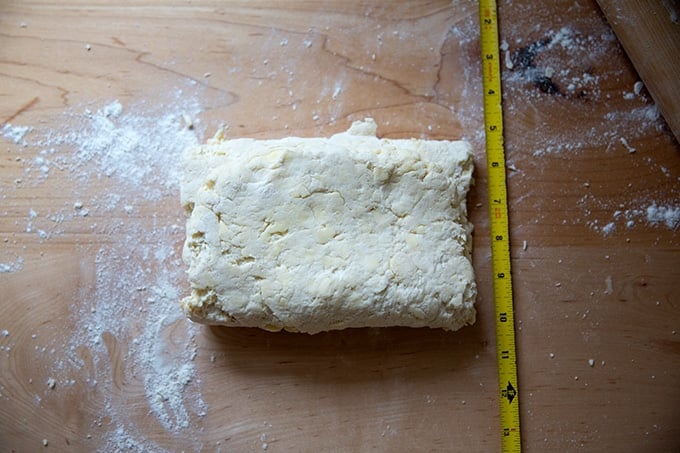
Turn the block 90 degrees.
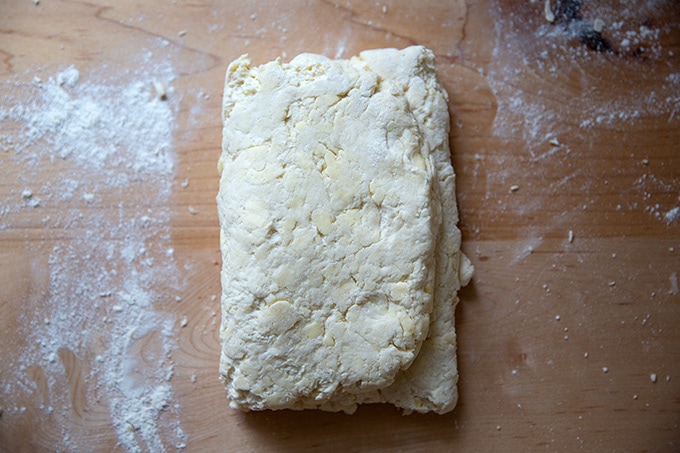
You’ll repeat this rolling-and-folding proces twice more.
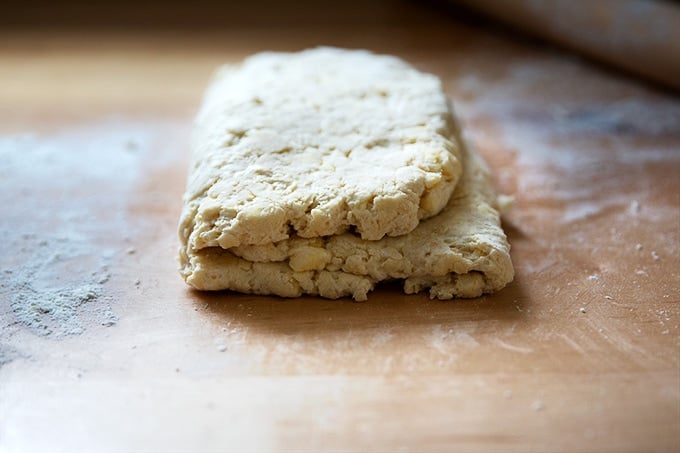
After the third set of fold, pat the dough into a square.
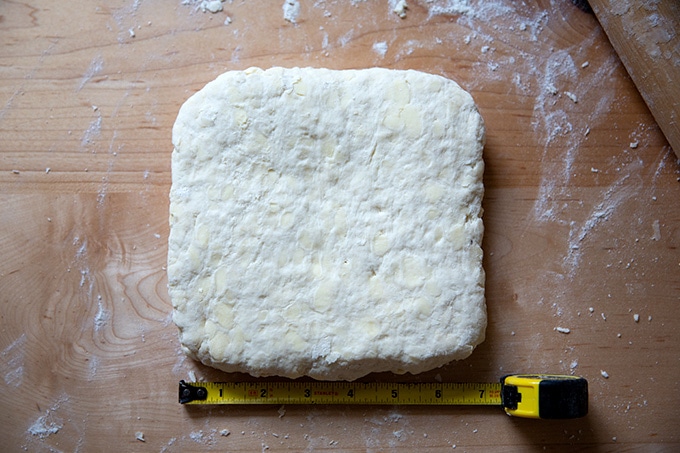
Cut the square into 9 equal pieces.

Transfer the squares to a sheet pan and chill for 30 minutes.

Then brush with a little more buttermilk and sprinkle with turbinado sugar if you wish.
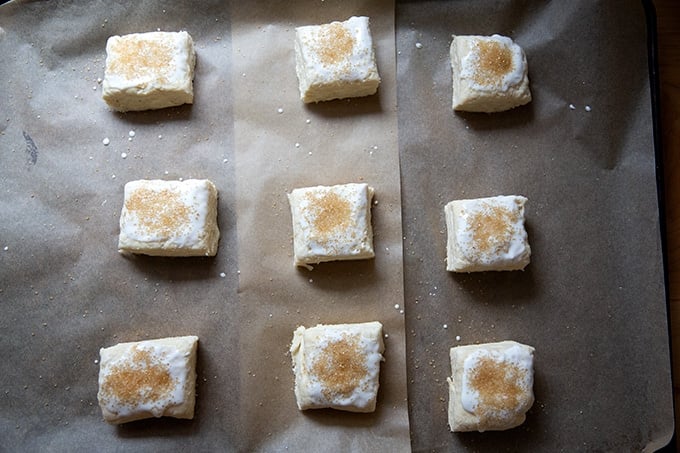
transfer to the oven and bake until golden, 25-30 minutes.
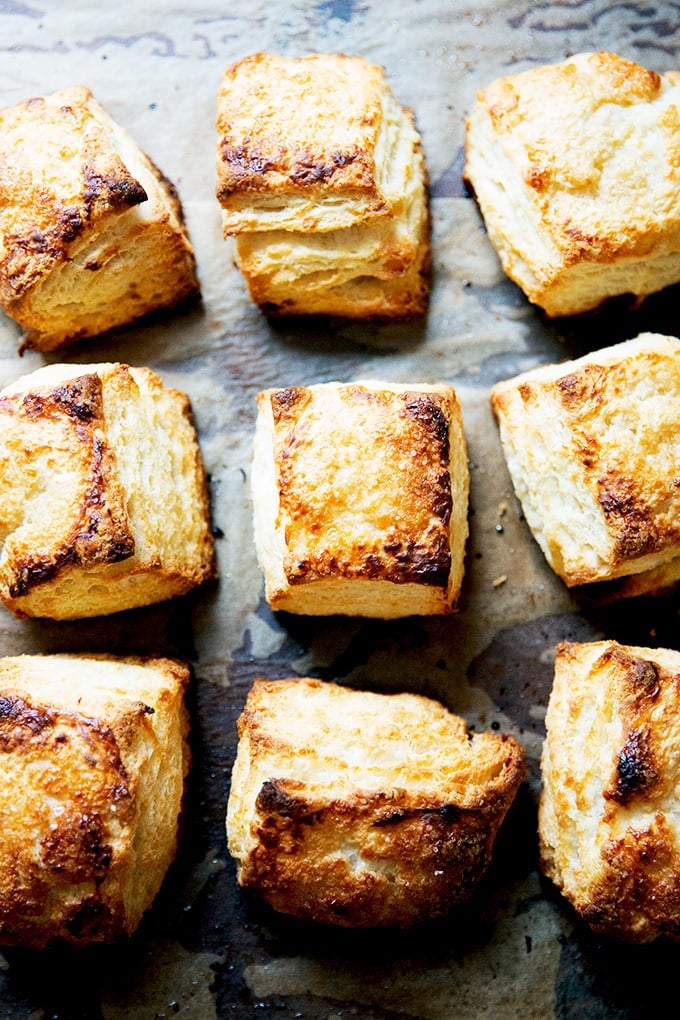
Look at those layers…

… irresistible.
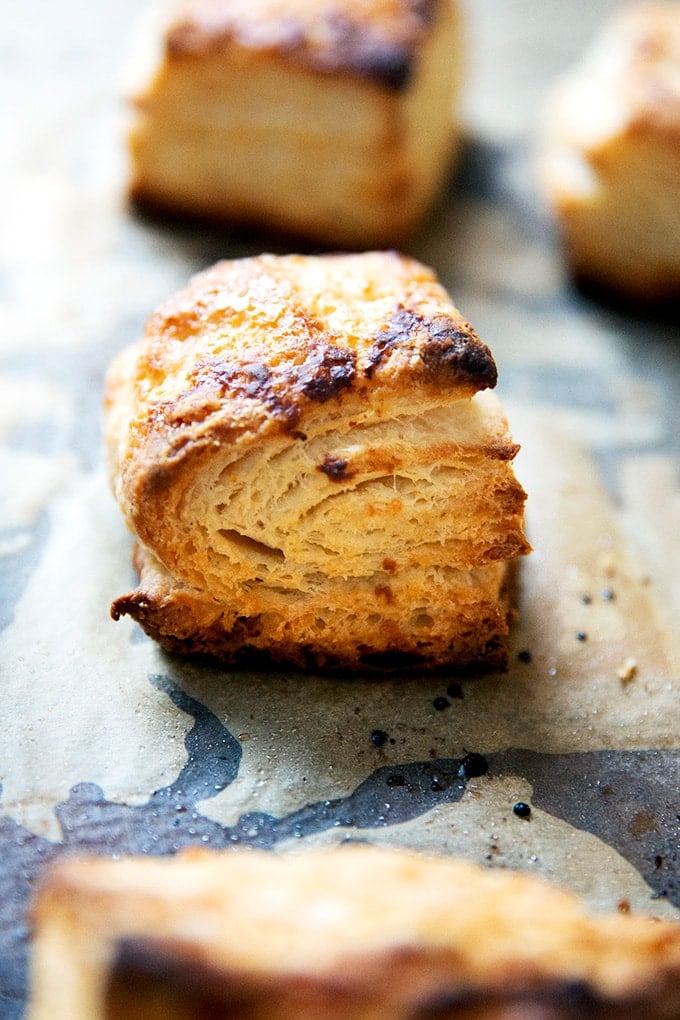
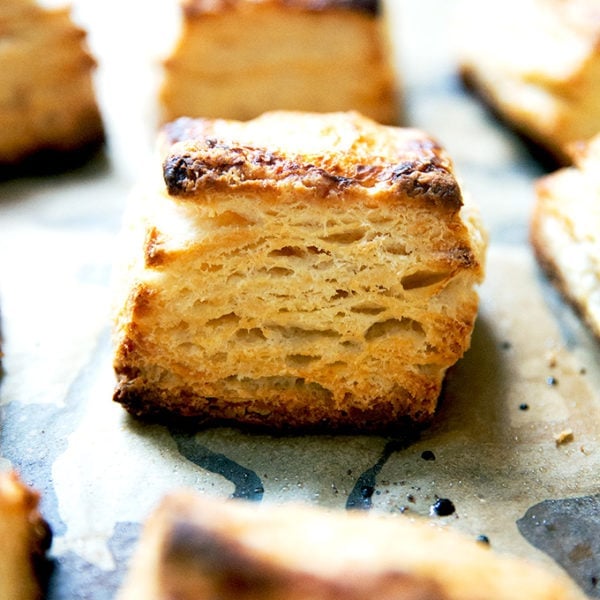
Flaky Buttermilk Biscuits
- Total Time: 1 hour 25 minutes
- Yield: 9 biscuits
Description
Adapted from Melissa Weller’s A Good Bake
As always, for best results, use a scale to measure.
I have made a few small changes to the recipe:
- I’m using a teensy bit more salt and baking powder.
- I’m using all-purpose flour exclusively as opposed to a mix of all-purpose and whole wheat pastry flour.
- I sprinkle the tops with turbinado sugar, because I love that salty-sweet dynamic.
- I’m using about 1/4 cup (70 grams) more buttermilk, which is an amount you might need to play around with. I’m using super thick buttermilk (Argyle Cheese Farmer, if you are local), and depending on the thickness of the buttermilk, you may need more or less. If when you are incorporating the buttermilk into the butter-flour mixture the mixture feels dry, add more buttermilk by the tablespoon until the dough comes together.
- To make homemade buttermilk: Fill a measuring cup with 300 grams (1.25 cups) of milk 2% or whole preferably, add 1.5 tablespoons vinegar or fresh lemon juice. Let stand for 5 to 10 minutes. Give it a stir; then use.
Ingredients
For the biscuits:
- 2.75 cups (355 g) all-purpose flour
- 2 teaspoons (9 g) baking powder
- 2 teaspoons (9 g) sugar
- 1.5 teaspoons sea salt or 2 teaspoons kosher salt (10 g)
- 16 tablespoons (226 g) cold cubed butter, salted or unsalted
- 1.25 cups buttermilk (300 g), see notes above
For finishing:
- 2 tablespoons (32 g) buttermilk
- 1 tablespoon (16 g) turbinado sugar, optional
Instructions
- In a large bowl, whisk together the flour, salt, sugar, and baking powder. Add the butter and use the back of a fork or a pastry cutter to “cut” the butter into the dry ingredients. The butter should be the size of peas in the end. You can also do this in the food processor: pulse ten times at 1-second intervals.
- Add the buttermilk and stir with a spatula to combine. You may need to knead the dough briefly with your hands to help the dough form a cohesive ball, but go light — you do not want to overmix here.
- Turn the dough out onto a lightly floured work surface and pat into a 6-inch square (roughly). Dust a rolling pin with flour, and roll the square into a 14-inch long rectangle. Fold the top third down. Fold the bottom third up. Rotate the dough 90 degrees. Repeat this rolling and folding process twice more. After the final set of folds, pat the dough into a 6-8 inch square. Use a bench scraper or knife to cut the dough into 9 equal portions.
- Place a rack in the upper third of the oven, and heat it to 400ºF. Line a sheet pan with parchment paper. Transfer the portioned biscuit dough to the sheet pan and transfer it to the fridge for 30 minutes. Brush the tops of the biscuits with buttermilk and, if you wish, sprinkle with turbinado sugar. Because I find the bottoms of my biscuits to brown too quickly, I set the sheet pan on another sheet pan to bake — do this if you wish.
- Transfer the pan to the oven and bake for 25 to 30 minutes. Remove the pan from the oven and transfer the biscuits to a cooling rack immediately.
Notes
3 Ways to Make These Biscuits Ahead of Time (Fridge/Freezer)
- You can freeze the baked and completely cooled biscuits in an airtight container for up to 3 months. Thaw them overnight at room temperature. Reheat them at 350ºF for 15 minutes before serving.
- You can transfer the unbaked portioned biscuits (or the square of biscuit dough) to the fridge for as long as 2 days.
- You can freeze the unbaked portioned biscuits. Freeze the cut biscuits (without the buttermilk wash or sugar topping) on a sheet pan. Once frozen, transfer to an airtight bag or vessel and freeze for up to 3 months. Bake them directly from the freezer — apply the buttermilk wash and sugar to the frozen biscuits — then transfer to the oven. The biscuits will need a few more minutes so rely on visual cues: golden tops and bottoms.
- Prep Time: 60 minutes
- Cook Time: 25 minutes
- Category: Bread
- Method: Oven
- Cuisine: American
This post may contain affiliate links. Please read my disclosure policy.




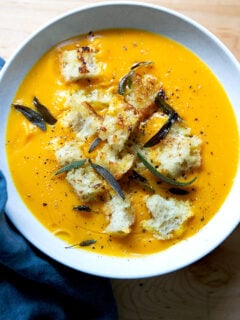
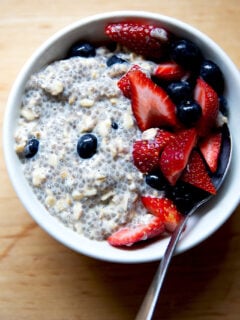
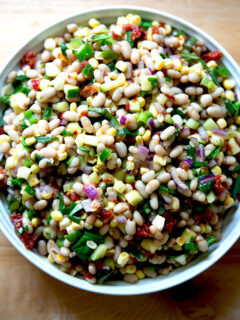





46 Comments on “Flaky Buttermilk Biscuits”
A question and a comment. First, why no baking soda? I was taught to use a bit to counteract the acid in the buttermilk.
Second, a straight cut on every side will help with a more even rise all the way around. If I have enough left over dough after making all the cuts, I make one ugly biscuit that won’t rise well, but will still be delicious with a little honey or jam for breakfast the next day.
So interesting Carmen! I saw a recipe that called for doing that, and I thought: that’s so wasteful, but it makes total sense, and if you save those scraps and re-roll them, it’s not wasteful at all. Thanks for sharing that tip.
Regarding the baking soda question: When a recipe calls for baking soda, there has to be some sort of acid present to react with the soda to create carbon dioxide, which will make the baked good rise. When a recipe calls for baking powder, which is a mix of baking soda and cream of tartar, which is an acid, the inclusion of an acid, such as buttermilk, is less important. Most baking powder is double-acting, meaning CO2 will be produced at two different phases: first when the batter is mixed (due to the liquid in the batter activating the base and acid), then when the dough is placed in the oven (due to the acid being both hot and wet).
Also:
Batters made with baking soda should be baked shortly after mixing because the gaseous bubbles dissipate quickly.
Batters made with baking powder can be stored for longer (even in the fridge overnight).
Does that clarify?
I would love to try this recipe, but eat gluten free, so am wondering if it can be converted?
Thank you, Judy
Hi Judy! Gluten-free flour is a bit of a different animal, and all gluten-free flours behave a little differently. I don’t know how to advise, and I would hate to steer you wrong. I might consider googling gluten-free biscuit recipe as opposed to trying to convert this one. Good luck!
I only have dried buttermilk(or rather powdered buttermilk) how do I use it for this recipe?
It will work great! Reconstitute it as instructed on the package — usually it’s 1/2 cup water for every 1 tablespoon of powdered buttermilk — then proceed.
OMG—- Made these today to see if they would make the Thanksgiving menu and possibly bump the Buttermilk Pull Apart Rolls…. YUM!!!! baked for 30 mins, the sugar on top is key. I plan to make the dough, keep as a square and then cut into portions and bake on Thursday. Thank you Ali!
That is a great plan, Mikki! So glad they made the Thanksgiving Menu cut 🙂 🙂 🙂 Thanks again for writing and Happy Thanksgiving!
Made these today to see if they would have a spot on the Thanksgiving menu—- – YES!!! Very easy. Used all of Ali’s suggestions, kept the cut portions in the frig for about 2 hours and then baked. Make sure to put the sugar on top. Happy Thanksgiving!
So nice to hear this, Mikki! Thanks so much for writing 🙂 🙂 🙂 Happy Happy Thanksgiving to you!
I made these biscuits this and they came out flat. What did I do wrong. They were delicious but flat and no layers 😳🤔
Please advise.
This morning. Sorry for the nonsense sentence.
Oh no! Is your baking powder fresh? Did you use a scale to measure the ingredients? Did the dough look comparable to the photos/video when you were done mixing it?
I did use a scale and my buttermilk is very thick. My dough looked like your photos/video. The baking powder is in date but I did purchase it a while ago (Bob’s). I’m thinking it may have lost it’s oomph.😜 just purchased a smaller container of bp and with try again.
The yeasted dinner rolls were wonderful for Thanksgiving, btw.
OK, so interesting, thanks for reporting back. I’ve referenced some other recipes, and some call for 2 tablespoons of baking powder, which seems extreme — I feel like you would be able to taste the baking powder. That said, I wonder if you could increase the amount to 1 tablespoon (3 teaspoons) without adverse effects in terms of taste but with positive effects in terms of rise. I will try more baking powder next time around and report back.
Great to hear the yeasted dinner rolls were a success. Hope you had a wonderful Thanksgiving!
Disappointment! All my butter ran out of my biscuits, suspecting it was the double sheet pan? I did chill the dough, not sure where else I went wrong? The dough was very wet. I’m sure they’ll taste good but are swimming in butter at the moment.
Oh no! That’s a bummer. I made many versions without the double sheet pan, and I found the double sheet pan really made a difference for me in terms of preventing the bottom from being too brown, but it’s possible you don’t need to do that.
Questions: did you use a scale to measure? It’s possible the type of buttermilk is making a difference — mine is very thick. I’ll make a note to use less buttermilk if it’s on the thin side. Are your sheet pans insulated?
I had the same problem. Pools of butter all over the pan and very flat biscuits. I weighed all ingredients and followed all directions. I believe the double sheet pan was the culprit. Will try again!
Bummer to hear this! I’m sorry. I need to revisit this recipe as well.
Hi! I’m going to try these in the next few days, they look fabulous!
One thing I just don’t understand—this recipe and others I’ve seen call for the dough to be rolled and given a letter-fold, several times. How is it that this method doesn’t create a tough biscuit?
I mean you’re really working the dough quite a bit, which is usually what you avoid with pie and biscuit doughs.
I’m not second-guessing, I’m sure it works because you’ve made them, but maybe you could explain how it works and why it doesn’t get tough!
Thanks!
Ali, I couldn’t wait to try these! And they didn’t disappoint, even tho I forgot to set the timer!
Used my food processor to blend in the butter which made it super easy. Wondering if I can shape them into a round shape before baking.
Thank you again to introducing all of your readers to something fun and easy.
Happy Thanksgiving to you and your family, Elizabeth
So nice to hear this, Mrs. B! Using a food processor is such a good idea here … the pastry cutter requires a lot of elbow grease. Yes, you definitely can cut the biscuits into rounds. You’ll just have to re-roll the scraps. Happy Happy Thanksgiving to you and everyone! xoxo
It’s 8:40 and freezing, I have a sick 5 year old that won’t go to bed and instead, keeps coming to my room to ask if I can make him the “bread” from the video we watched the other day for breakfast. Alas, I failed to get buttermilk, is milk or cream a suitable substitute?
Oh poor thing … I’m sorry. You can use either milk or cream, or you can make your own buttermilk by combining milk with a little bi of vinegar and letting it stand for a few minutes: Fill a measuring cup with 300 grams (1.25 cups) of milk 2% or whole preferably, add 1.5 tablespoons vinegar or fresh lemon juice. Let stand for 5 to 10 minutes. Give it a stir; then use.
Made last night and these were a 15/10, sooooooooooooooo delicious! Even toped with sugar, and a couple I tried sugar and some Diamond Salt, unbelievably good. I made my own buttermilk per the notes in the recipe and per notes the dough was a little wetter because it was not a thick buttermilk, added a bit more flour and they turned out perfect.
Yay! So great to hear this, Kim 🙂 🙂 🙂 And so great to hear you were able to use a little bit of flour to make up for the wet dough. Thanks so much for writing.
Made these exactly as written and without using scale to measure. I’m familiar with dough, but have never made biscuits before. These were so quick and easy to put together and turned out exactly as pictured. Buttery, flakey and delicious! Tried with and without sugar topping – with sugar is the winner.
So great to hear this! Thanks so much for writing. And yay for the sugar-topped winner 🎉🎉🎉🎉🎉
I just made these biscuits and they were the bomb! The recipe is simple, easy to follow. I did use the double sheet pan trick, but also had to cover the tops with foil before they were done inside. I did not add sugar to the tops since we’re using them for biscuits and gravy. The end result was a tender, fluffy biscuit that we all loved. Thank you for sharing!
Great to hear this, Tiffany! Thanks so much for writing and sharing your notes. Biscuits + Gravy = Heaven. Happy New Year!
Best bread recipe I’ve come across. We love it!!
Great to hear, Beverly!
Hi there!
I’ve been watching the bake off shows (Canadian and British) and they grate their butter for rough puff pastry, do you think that would work instead of the fancy tool you use here?
Sincerely, hopeful!
Yes, absolutely! Go for it!
I love the taste texture of these, but try as I might they don’t rise like the ones pictured.
3 attempts last was with fresh baking powder, flour, and buttermilk. Great tasting, just not great rising. Would love any tips to fluff them up.
Flawless first attempt – I followed your video exactly and couldn’t be more pleased with the outcome. Flakey with many layers. Golden brown on top and buttery taste throughout. I tried turbinado sugar but not really tasting it, maybe I need a little more than just a sprinkling. Love your website and especially the videos that accompany the recipes.
So great to hear this, Nick 🙂 🙂 🙂 Thank you for your kind words. Means a lot. Regarding the turbinado sugar, you could definitely try using a heavier hand. If you still don’t notice a difference, you could try a different sweetener such as maple syrup… Joanne Chang of Flour Bakery uses maple syrup + sea salt.
I made these biscuits and did not have the same result as your recipe. I went into making these quite confident because I would consider myself to be a very good baker. Just last week I made some cheddar scones that were tall and flaky with a beautiful flavor and texture.
Half way through this bake, there was butter pooling around the biscuits. One addition is that I used cake & pastry flour which I never do. Sooooo….. I’m putting my bet on the fact I used that flour!!
In the end, I removed fairly flat golden brown biscuits that taste great, but don’t look so hot!
Hi Suzi! Bummer to hear this. I don’t think it’s your flour though. I’m wondering how the ratios of flour to butter compare to the cheddar scones you made recently. My first thought is about the butter, and if there’s any chance it wasn’t in small enough pieces? When butter seaps out of pie dough, for instance, it’s often because it’s not incorporated into the dough as much as it should be.
Is it normal for the biscuits to end up sitting in melted butter after baking? Mine lost about 2-3 tablespoons. Glad I used a rimmed pan 🙂
Oh bummer! It’s possible the butter wasn’t cut into small enough pieces? I also always wonder when these issues arise if the type/brand of butter is playing a role. Do you recall what brand you used?
Hi Alexandra! Would it be possible to use self rising flour for this?
Thanks for being such a rock star!
I think it could work, but you might want to eliminate the baking powder as a result? I would look on the package of the flour and see if there are any guidelines about using it in recipes that already include leaveners.
Plan to bake ,soon
Just made these. Super easy and they came out great. Cooked for 30 minutes, they were still kind of pale at 25 in my oven. Used one pan. They’re brown on the bottom but not too browned. I don’t know how well it would work but I’d like to double the recipe and cut thicker biscuits.
Doubling should work just fine! Great to read all of this. You can try increasing the temp if you’d like more browning on the top, and you can double up the sheet pan to make sure it doesn’t brown too much on the bottom.